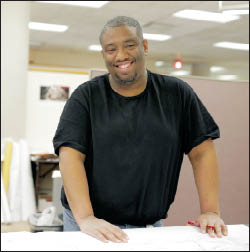I remember the “old days” of surveying when GPS was the new kid on the block, and GIS and laser scanning were mere toys. I first used GPS in 2001 when I interned in south Florida, and it seemed like such a luxury. Since I was the new guy, all I had to do was babysit the base station while the rest of the crew occupied other points in the area. So there I was, sitting in a lawn chair on Key Biscayne reading the day’s news and enjoying the view of the Atlantic Ocean. This GPS stuff was something I could get used to.
I practice surveying in the Philadelphia region for Pennoni Associates, a multidiscipline engineering firm with offices from Massachusetts to Virginia. Although, like everyone else, we took our hits in the recent economic downturn, things seem to be looking up for us as a firm and the region as a whole. Two things give me this impression: first, on a clear day from my office, you can spot up to six cranes diligently working across the city to change the Philadelphia skyline; second, we have this weird thing at the office called a “backlog,” and it keeps growing. 2014 is shaping up to be a good year.
2014 is shaping up to be a good year.
My focus recently has been concentrated in laser scanning technology. Pennoni was early in acquiring scanning tools, and we’ve been working hard since to sharpen our expertise and find new and innovative ways to serve our clients using the technology. Terrestrial scanning, aerial lidar, and other laser scanning technologies are not new ideas, and their standard applications have been around for quite some time, but working with our clients to find innovative ways they can take full advantage of the data that these services offer has been a great challenge. It seems that every day we are uncovering a new or unconventional use for the technology.
What I have found is that for me, it is not just external clients who are becoming more curious about scanning; many of my colleagues on the engineering side at Pennoni are beginning to see the value of this technology and cross-promoting it on their projects with their clients. Thanks to these inroads, we’ve been enjoying the opportunity to expand into forensic surveying, quantity calculations, and interior building scanning for BIM, as well as other areas.
While I still enjoy the traditional survey work that we undertake for our clients, the metamorphosis of the traditional surveyor into the “Geospatial Professional” is one that I have embraced, and our industry as a whole should revel in what this means for us. Expanding markets, increased opportunities, and greater collaborations with other professional service disciplines are among the exciting possibilities for the future.
—Shaheed
Guest Editorial: Space-age Metamorphosis
It’s an exciting time to be a surveyor. When I consider where the profession is today, it is amazing how much we have evolved from where surveying was when I started 18 years ago. Things that seemed space-age back then are now the backbone of our industry, and we have barely scratched the surface.
